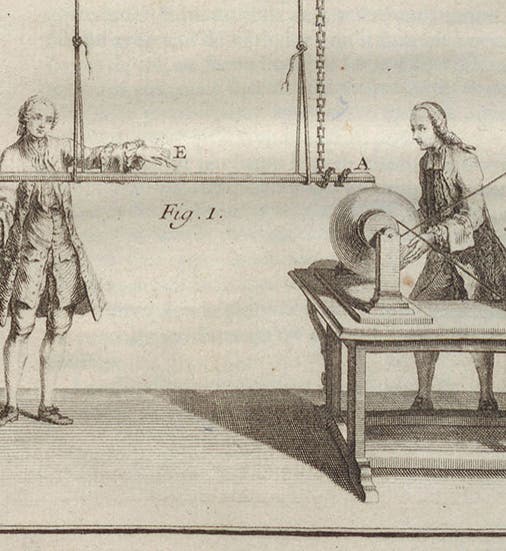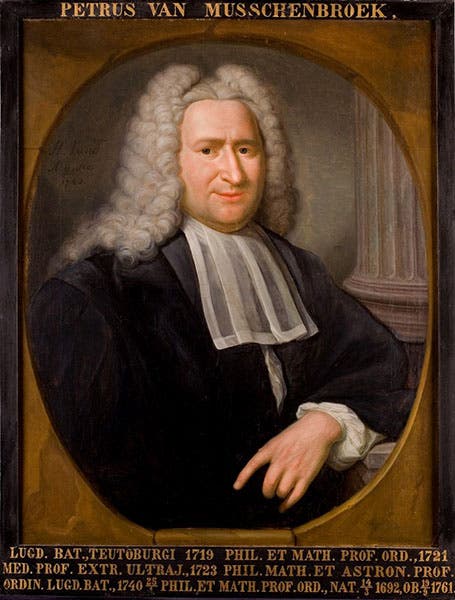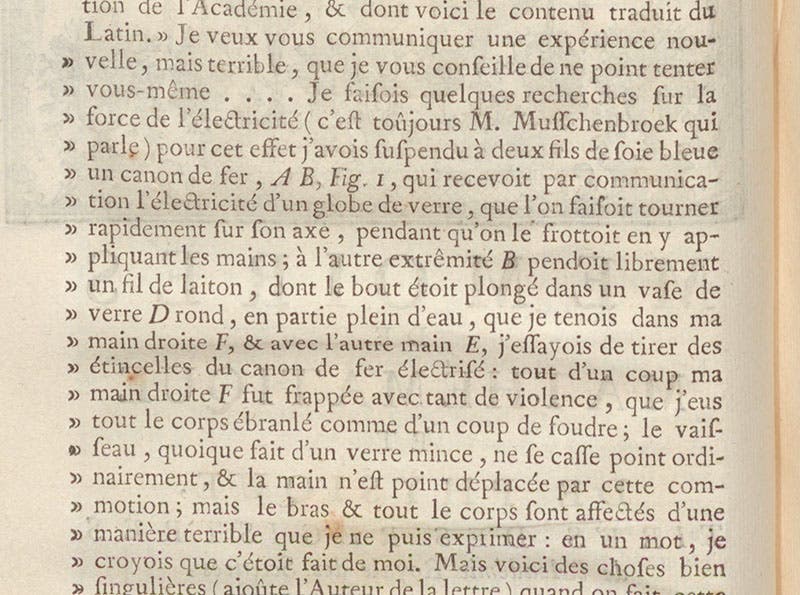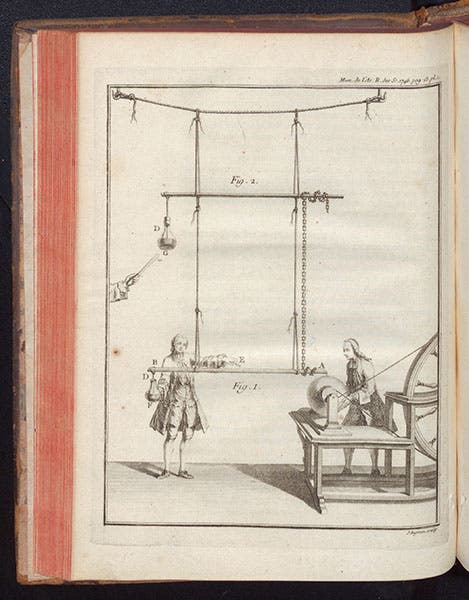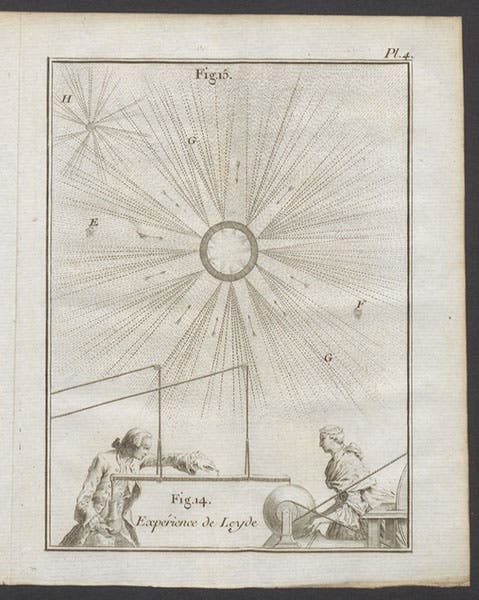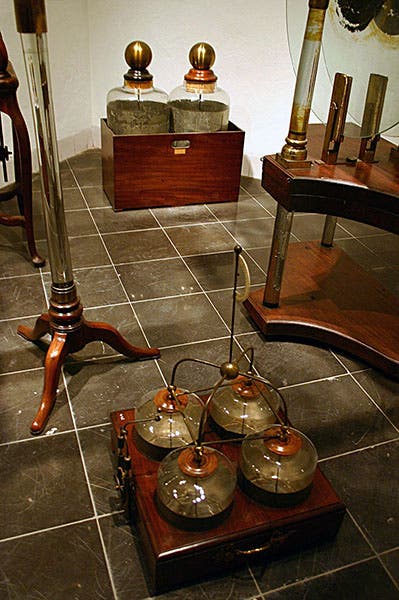Scientist of the Day - Pieter van Musschenbroek
Pieter van Musschenbroek, a Dutch experimental scientist, was born Mar. 14, 1692. Musschenbroek’s father was an instrument maker, specializing in double-acting vacuum pumps, a family business that Pieter’s older brother continued. Not surprisingly, Pieter grew up with an interest in instrumental science, but he took the academic route, becoming a professor, first in Duisburg, then Utrecht, and then finally, in 1739, in Leiden. He was a prolific author of books on experimental science, many of which we have in our collections, in multiple editions. But today’s date, Jan. 20, 2022, mandates that we concentrate on one particular aspect of Musschenbroek’s career. For on Jan. 20, 1746, Musschenbroek wrote an excited letter to a French colleague, Réne-Antoine Ferchault de Réaumur. Musschenbroek began his letter (in Latin): “I would like to tell you about a new but terrible experiment, which I advise you never to try yourself, nor would I, who have experienced it and survived by the grace of God, do it again for all the kingdom of France.”
Musschenbroek had found a way to store electricity in a bottle. He discovered that if you half-fill a glass bottle with water (it must be German glass, he claimed!); insert a metal rod, with a knob on the end, into the jar; and hold the knob to a prime conductor connected to an electrostatic generator, you can fill the water with invisible electric fluid. You couldn't see it, but it was definitely there, and in prodigious quantity, because if you held the jar in your left hand, and touched the knob with your right, the shock would knock you off your feet. Musschenbroek had made what we would call an electrical capacitor. His contemporaries called it a Leyden jar.
It turns out that Musschenbroek did not invent the Leyden jar; he was preceded in his work by Jürgen von Kleist in far-off Pomerania. Nor did Musschenbroek discover the key to charging and discharging a Leyden jar – hold it in your hand; that was painfully discovered by a lawyer colleague of Musschenbroek. But Musschenbroek wrote the letter to Réaumur, who passed it on to the abbé Nollet, who read it to the Paris Academy of Sciences on Apr. 20, 1746, and successfully duplicated the experiment (he found that Parisian glass works just as well as German). It is said that Nollet coined the term “Leyden jar,” and perhaps he did, but I could not find the term in his published paper, although he makes copious use of the phrase “experience du Leyde”.
We show here details of the opening page of Nollet’s paper (third image, above), and the second page, with the beginning of the translation of Musschenbroek’s letter (fourth image, just above). You can perhaps make out the phrase at the top: “experience nouvelles, mais terrible” (for some reason the last half of Musschenbroek’s first sentence is elided – perhaps Nollet did not want to scare away future experimenters). We also reproduce an engraved plate that accompanied Nollet’s paper, showing what is presumably Musschenbroek himself holding his jar in one hand and about to touch the prime conductor with his other hand, completing a circuit he wished he had left uncompleted (fifth image, below). A detail from this plate opens our post. One wishes there were a follow-up engraving, showing Musschenbroek just a split-second later.
Fortunately, Nollet published an entire book on electricity later that year, and here he provided the wished-for illustration, in the form of an engraving (sixth image, below). At the bottom, a curious soul is about to perform the “Leyden experiment.” The rest of the the plate shows someone’s impression of what it feels like to touch the knob of the jar. As one who has done the experiment, I would say that it captures the feeling quite well.
There are lots of 18th-century Leyden jars still around, scattered through various museums, especially in the Netherlands. We thought it would be appropriate to show you here two sets – a group of four jars in the foreground and two in the background – that are in the Boerhaave Museum, since the Boerhaave Museum is in Leiden (seventh image). These Leyden jars are now Leiden jars.
Musschenbroek deserves to be remembered for more than just his experiment and his jar. On some future occasion, we will mine his publications for some of his other experimental work. We also need to write a post on Pieter’s father, Johan, and his vacuum pump, for which there are several contemporary engravings, as well as surviving specimens in several Dutch museums.
Finally, should you look at our post on Kleist, you will see there another illustration of Musschenbroek and the Leyden experiment, this one a wood-engraving in Louis Figuier’s Les merveilles de la science, 1867. The date Figuier provided, Apr. 20, 1746, is the date Musschenbroek’s paper was read to the Academy by Nollet, not the date of the original experiment, which was shortly before Jan. 20, 1746.
The portrait (second image), painted the year that Musschenbroek succeeded Willem‘s Gravesande in the chair of experimental physics at Leiden (1741), is in the University of Leiden portrait collection.
Dr. William B. Ashworth, Jr., Consultant for the History of Science, Linda Hall Library and Associate Professor emeritus, Department of History, University of Missouri-Kansas City. Comments or corrections are welcome; please direct to ashworthw@umkc.edu.

